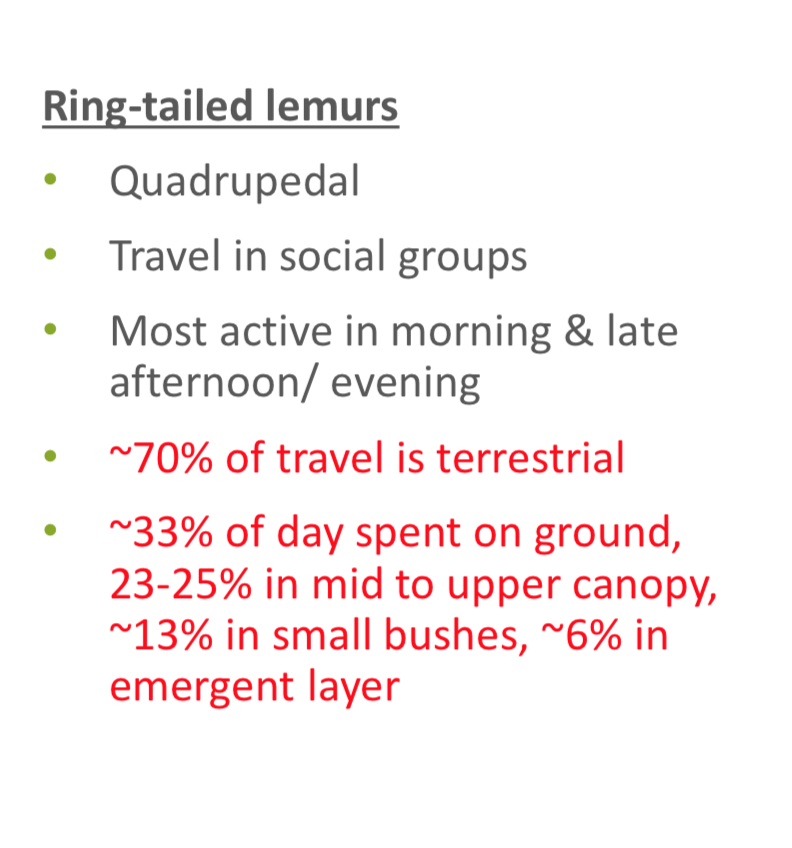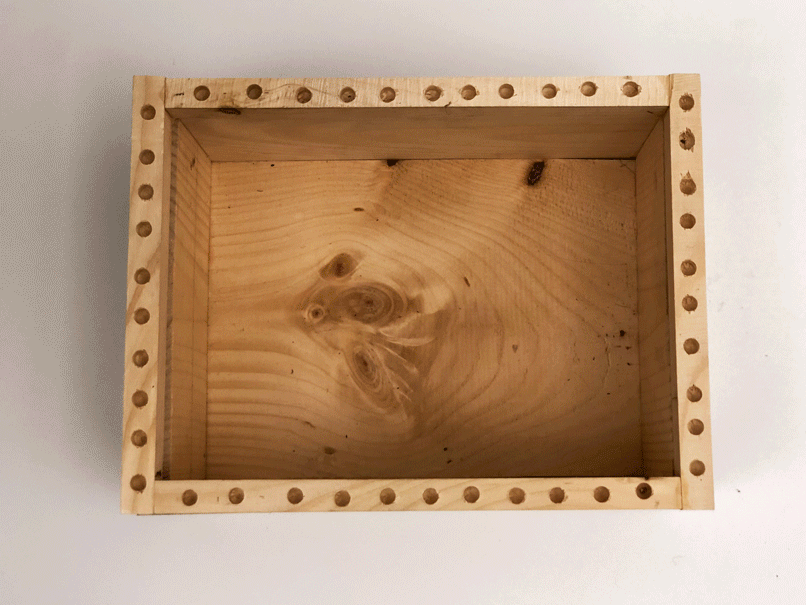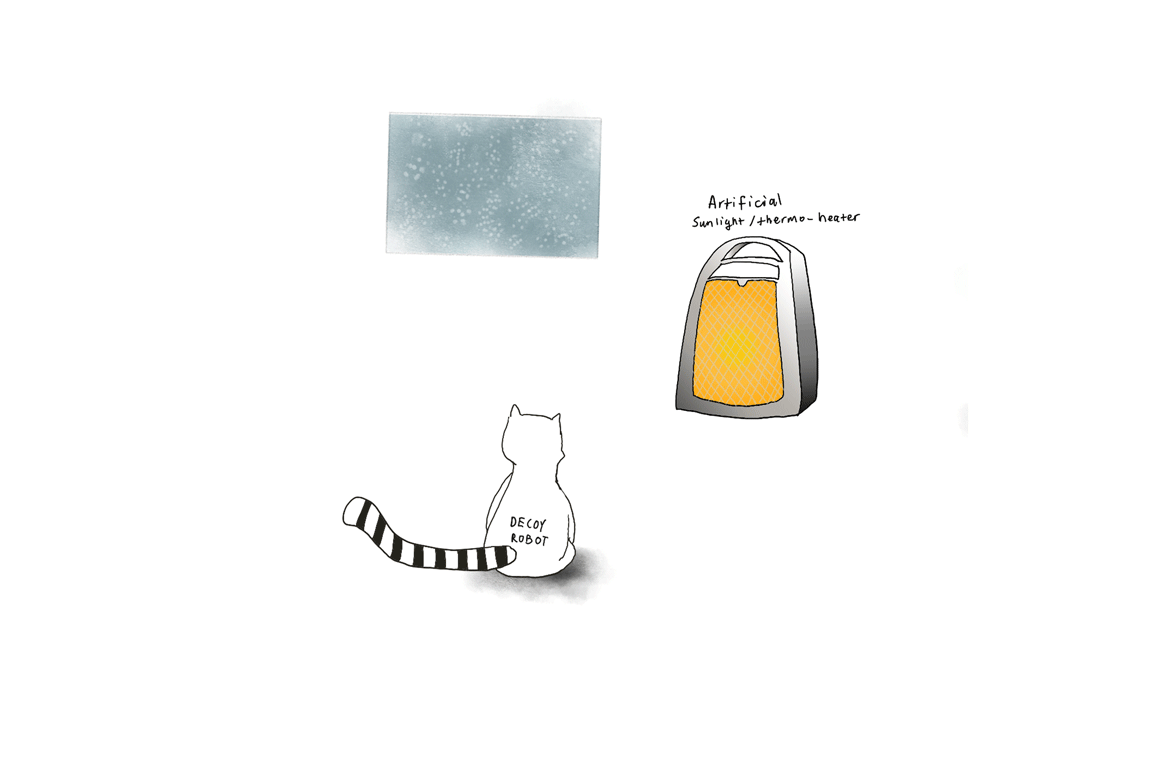Week 4-5
Enrichment Prototype for Ring-tailed Lemurs
Big Idea: To create an enrichment intervention– a ground-based foraging extraction platform that challenges Ring-tailed lemurs to work for harvesting food through digging and probing, ultimately promoting their natural behaviors and improving welfare in a zoo setting.
User: a Ring-tailed Lemur

Initial development goals:
1. Highlight the relation of behaviors to affordances in each of the
proposals
2. Invite the lemurs to interact with it
3.
Look for new behaviors rather than just sticking to the feeding
mechanism
4. Make the enrichment intervention challengingly
and pleasantly engaged
5. Optimize the building structure and
find durable materials for easier zoo maintenance
6. Back up
every behavior, steps of interaction with research and potential
speculation

While I’m exploring the answers to these questions, I started to do more research on specific behaviors and habits of Ring-tailed lemur, which will hopefully give me new insights into developing the affordances of any of my proposal. I found a report written by Tracy Fenn, the supervisor of mammals at Jacksonville Zoo, called “Behavior-based husbandry for lemurs.” He listed key points that further pinpoints the importance of creating based on species’ natural history and individual needs and creating responsive to objective evidence of welfare. It reminded me that my intervention will need to be durable, flexible in formats, and fits Lemurs’ natural behaviors.


Insight: Ring-tailed lemurs spend a lot of time on the ground, which is unusual among lemur species.

many food probing toys found(not just Ring-tailed lemurs)are hung. It'd be unique to have something that follows their natural behavior.
Initial Sketch for the box structure:

I encountered a paper called “Lemur Use of Hands Versus Mouth” that presented how most Ring-tailed lemurs are left-handed. Meanwhile, when foraging and feeding, Ring-tailed lemurs tend to use a single hand rather than both hands. How the was measured was through determining “If a hand was used to bring food or some other object to the mouth, the specific hand utilized was recorded”.

That means when interacting with the box, potentially Ring-tailed lemurs will probe and grab the food with one hand to deliver to the mouth. That means gauging the opening gaps doesn’t need to consider fitting both hands of a lemur as long as the gap fits one, and potentially their other hand will be simultaneously used to pull the string or dig into other gaps for food.
More questions for developing the prototype for the "Ground foraging
grid box":
1. What materials should I use for durability and safety?
2. How to make it more challenging and engaging for lemurs to
interact with?
3. Will lemurs compete and incite fights with
each other through food probing?
4. What if one claim
territory over the box?
5. Can this box only exist on the
ground/underground? Can it change form and replacement?
6. How
to make it hard to break or to hack for the lemurs while easy for
the zookeeper to maintain and update?
7. What are some of the
specific locations within the captivated environment can this
intervention be placed?
In-Ground Foraging Grid box – Further development:
Affordance:
* They spend a great deal of time on the ground, the opening grid should be placed near where they like to gather when introducing for the first time* The fruit/nuts/leaves will be visible through the opening grid from the ground level, so the box will catch lemurs’ attention
* the opening space in-between the string grid varies in sizes, some are much bigger than their hand size, so they should be able to get some food without really digging
* Some fruit will be placed at a more shallow level, so it’s easy to grab for the first-time user
Challenge and Engagement:
* Since lemurs would like to work to get their food, the grid opening will vary in sizes based on how the string/rope is weaved. At the beginning of introducing the box, the gap can be wide then slowly it can become tighter(weave tighter)* In order to create a bit more of the challenge while maintaining the modular attribute, different heights of a wooden block can be inserted in the box to create a different level of the surface. Or on the hand, can make the food closer to the surface level for an easier reach.
Flexibility
* The box will be modular in forms of additional platform-riser inserts, adjustable string grid* the lid can be detached easily from the bottom for the box cleaning and food refilling
* the box can be hung on a vertical surface when needed, so it doesn’t have to always be placed underground
Parts and Materials
* Bottom boxwood* Top lid - wooden frame, wooden pegs and strings(TBD, considering jute or nylon or polyethylene)
* wooden block inserts
* Ideally, the wall wood would be abled to module into different depth
Making in the process:
I decided to stick with wood for the current as it’s natural and very easy to be made into modular iterations in the future. For this prototype, I focused on addressing the modularity of the grid and the box depth.


The modularity of the grid is achieved by removable wooden dowels, which would allow the grid to be mapped in different(tight or loose) ways for easier or more difficult lemur-hand navigation.

The material of the rope is jute, which is natural and not too tight.

Meanwhile, the modularity of the box depth is achieved by different sizes/heights of wooden blocks inserts, so food cane placed at different level heights while being placed in the box, giving Ring-tailed lemurs levels of challenge of foraging.

Ideally, the box body itself will be sliced into modular frames as well, so we can have the options of having a deeper bottom by stacking up more wall modules or the other way around.

Body-storming

Body-storming Feedback and Future Iteration:
* The furnishing like pure tung oil or mineral oil can be coated
inside and outside the box, so the box can be water-resistant, easy
for cleaning and safe for food placement.
* The jute can come out easily if the hand nudges slightly too much.
Lemurs wouldn’t be given instructions, so they could easily pull out
the jute as well. So, maybe we can use elastic food ties to anchor
the jute on each dowel.
* For my “human lemur”, he gave up reaching the food at the bottom
once he realized he couldn’t easily reach the deepest level, so
making the wall into modules that can stack up can create different
depth of the box. We can even lowly introduce the foraging play grid
to lemurs starting from a very shallow box.
* If this box can’t exist underground/in-ground due to zoo
environmental restriction, the box can be adjusted to a very shallow
depth to be put above ground. Moreover, by installing an anchor to
the side wall, such a box can also be hung onto a tree, so the
foraging digging can happen vertically as well.
Potential prototype 2:
While I’m in the process of prototyping the box, I generated some
new insights for the sunbathing project. (sketch below) My original
idea is to create a rotatory outdoor platform that allows multiple
lemurs to sunbath whenever they want. However, I realized such a
platform might not be as necessary in an outdoor/always sunny
environment like San Diego zoo, as they can easily move to a sunny
spot, However, in many other zoos like Bronx zoo, lemurs are kept
indoors during the winter season. Sunning behavior is important for
lemurs' thermoregulatory function, which is also the best example of
lemur species-specific behavior. In Taylor Shire’s paper”
Differences in behavior between captive and wild ring-tailed lemur
populations: Implications for reintroduction and captive management,
she mentioned: “ Indoor enclosures are temperature controlled using
centralized heating or heat lamps. In this situation, sunning no
longer serves a thermoregulatory function and therefore we would
expect that 1) lemurs in captivity will spend less time sunning than
wild lemurs and 2) lemurs housed in indoor enclosure will spend less
time sunning than those housed outdoors.
So it really depends on when and where were these ring-tailed lemurs
raised. If it has always been indoors, the opportunity for an
outdoor sunbathing spot might not be efficient. Mean while, Shire
also mentioned in her paper that “ the absence of this behavior may
indicate that the lemurs have no exposure to natural stimuli and may
not engage in other species-specific behaviors.” That means it’s
significant to an extent for ring-tailed lemur to be able to perform
this behavior, if we can imitate a natural stimuli. Lemurs are
usually found in social group. In a captivated setting, social
groups are usually “artificially managed”(Shire, 2012) due to
transferring among institutions, so lemurs could actually encounter
more frequent agnostic behaviors. So ideally and speculatively, if
Ring-tailed lemurs are in an indoor setting or under terrible
weathers, if an artificial sunlight can be introduced and a familiar
figure can be introduced to start the sunbathing, potentially others
would follow and even re-adapt it. The artificial sunlight will
imitate not only the color temperature but also the thermal
temperature of the sun, and the lemur decoy can be marked with a
female scent(female-dominant social group) that other lemurs feel
very familiar to.
the Sunbathing lemur decoy:

References
1. Fenn, Tracey. BEHAVIOR- BASED HUSBANDRY FOR LEMURS. Supervisor
of Mammals, Jacksonville Zoo and GardensFounder & President,
Endangered Primate Foundation (Prosimian Sanctuary)
2. Hosey, G. R. (2005). How does the zoo environment affect
the behaviour of captive primates? Applied Animal Behaviour
Science, 90(2), 107–129.doi:10.1016/j.applanim.2004.08.015
3. Inglis, I. ., Forkman, B., & Lazarus, J. (1997). Free
food or earned food? A review and fuzzy model of
contrafreeloading. Animal Behaviour, 53(6),
1171–1191.doi:10.1006/anbe.1996.0320
4. Kelley, E. A.,
Jablonski, N. G., Chaplin, G., Sussman, R. W., & Kamilar, J. M.
(2016). Behavioral thermoregulation inLemur catta: The
significance of sunning and huddling behaviors. American Journal
of Primatology, 78(7), 745–754.doi:10.1002/ajp.22538
5.
Kulahci, I. G., Drea, C. M., Rubenstein, D. I., & Ghazanfar, A. A.
(2014). Individual recognition through olfactory-auditory matching
in lemurs. Proceedings of the Royal Society B: Biological
Sciences, 281(1784), 20140071–20140071.doi:10.1098/rspb.2014.0071
6. Schoeck, C. N., & Edds, D. R. (2018). Lemur Use of Hands
Versus Mouth. Transactions of the Kansas Academy of Science,
121(1-2), 49–58.doi:10.1660/062.121.0205
7. Shire, Taylor,
"Differences in behavior between captive and wild ring-tailed
lemur (Lemur catta) populations: Implications for reintroduction
and captive management" (2012). Graduate Theses and Dissertations.
12459. https://lib.dr.iastate.edu/etd/12459